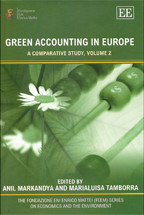Green accounting in Europe: four case studies

01.02.2005
Anil Markandya, Marialuisa Tamborra
Edward Elgar, Series on Economics and the Environment
Traditional measures of economic activity, such as GDP, take no account
of damage done to the stock of natural capital by environmental change
nor the loss of welfare that economic activity causes through increased
pollution. This book predominantly addresses the second question and
develops and expands previous research by the authors (Markandya and
Pavan, 1999). Using spatially disaggregated data on measures of
pollution to derive economic damage estimates, the main purpose of the
book is to gauge the environmental damage sustained as a result of
economic activities and to offer an insight into how the information
generated can be used in conjunction with conventional economic
accounts. The first few chapters review recent developments in both
green accounting and pathway analysis. The book goes on to evaluate the
progress made in estimating dose response functions and valuing
environmental damages. The authors discuss the methodology used for the
estimation of damages caused by ambient air pollution and the cost of
defensive expenditures. They also present the results of the analysis
and draw important policy conclusions for environmental accounting,
particularly in the EU. This book will be essential reading for
environmental economists, particularly those interested in issues of
environmental accounting.
Contributors: G. Crapanzano, K. Dorland, B.
Droste-Franke, S. Fankhauser, R. Friedrich, J.F.M. Helming, M. Holland,
D. Howard, A. Hunt, F. Hurley, K. King, W. Krewitt, O. Kuik, A.
Markandya, I. Milborrow, M. Pavan, J.B. Smith, F.A. Spaninks, M.
Tamborra, R.S.J. Tol, U. Triebswetter, A. Trukenmüller, P. Watkiss
Traditional measures of economic activity, such as GDP, take no account of damage done to the stock of natural capital by environmental change nor the loss of welfare that economic activity causes through increased pollution. This book predominantly addresses the second question and develops and expands previous research by the authors (Markandya and Pavan, 1999). Using spatially disaggregated data on measures of pollution to derive economic damage estimates, the main purpose of the book is to gauge the environmental damage sustained as a result of economic activities and to offer an insight into how the information generated can be used in conjunction with conventional economic accounts. The first few chapters review recent developments in both green accounting and pathway analysis. The book goes on to evaluate the progress made in estimating dose response functions and valuing environmental damages. The authors discuss the methodology used for the estimation of damages caused by ambient air pollution and the cost of defensive expenditures. They also present the results of the analysis and draw important policy conclusions for environmental accounting, particularly in the EU. This book will be essential reading for environmental economists, particularly those interested in issues of environmental accounting.
Contributors: G. Crapanzano, K. Dorland, B. Droste-Franke, S. Fankhauser, R. Friedrich, J. F. M. Helming, M. Holland, D. Howard, A. Hunt, F. Hurley, K. King, W. Krewitt, O. Kuik, A. Markandya, I. Milborrow, M. Pavan, J. B. Smith, F.A. Spaninks, M. Tamborra, R. S. J. Tol, U. Triebswetter, A. Trukenmüller, P. Watkiss
